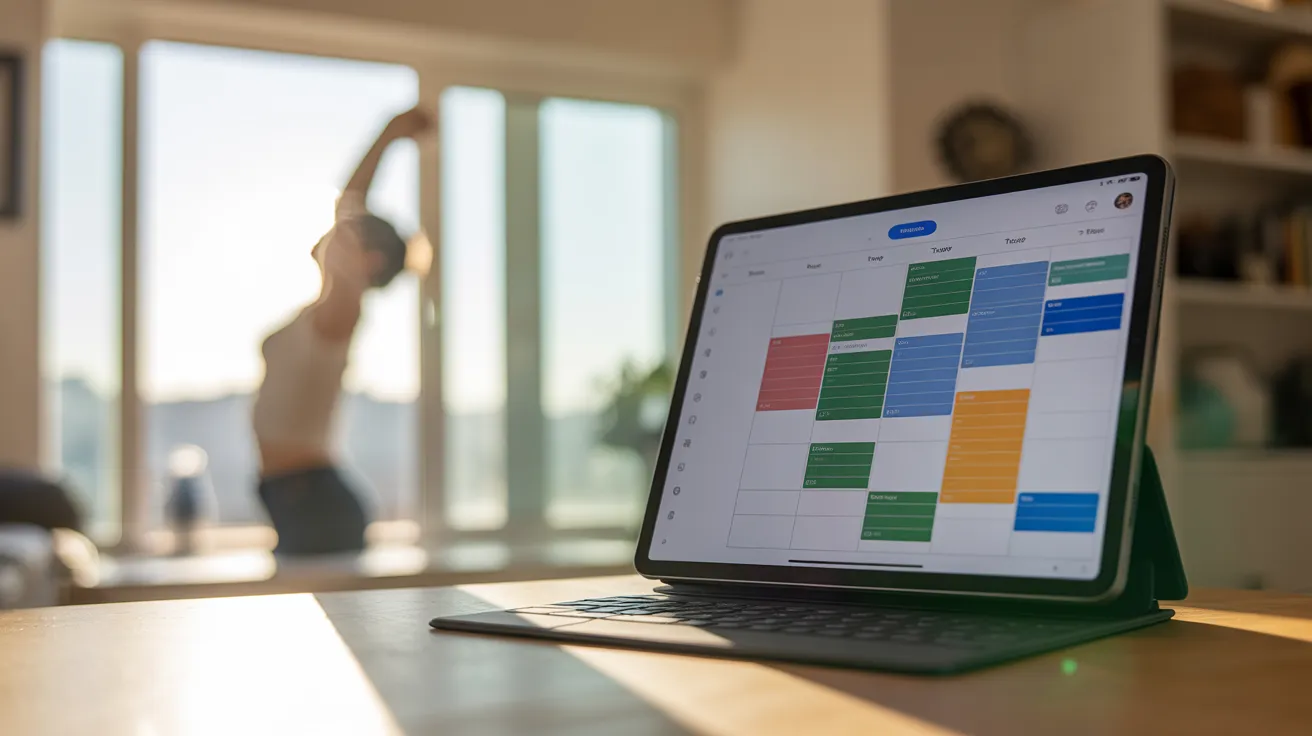
📚 Table of Contents
- The Real Secret to Instant Motivation: Friction Reduction
- From Digital to Physical: The 10-Minute Desk Reset
- Building Momentum with a 15-Minute Weekly Review
- Uncovering Hidden Time: The Power of a Mini Time Audit
- Essential Tools for Low-Friction Productivity
- The Compounding Effect: Chaining Your Motivation Hacks
- Putting It All Together: Worked Examples
- Frequently Asked Questions About Motivation Hacks
- Your First Three Steps to Sustainable Motivation
We’ve all been there. Staring at a blank screen, a mountain of tasks, or a project that feels utterly impossible. The feeling isn’t laziness; it’s paralysis. Your brain cycles through a hundred reasons why you can’t start, and the weight of it all pushes you toward the nearest distraction.
In these moments, we often believe the solution is heroic effort. We search for a surge of willpower, a lightning bolt of inspiration, or a magical productivity hack that will transform us into a focused machine. We tell ourselves to “just be more disciplined” or to “try harder.” This approach is a trap. It pits your finite willpower against an infinite sea of resistance, and it almost always ends in burnout.
The truth is, motivation isn’t something you find. It’s something you build. It’s not the cause of action; it’s the result of it. The real secret, the one that sustainable, high-performing people understand, is that small, intelligent systems will always beat brute-force effort.
This isn’t about overhauling your entire life overnight. It’s not about buying expensive planners or subscribing to complex software. The most powerful instant motivation hack is much simpler: you must systematically remove friction. You must make it easier to start than it is to procrastinate.
In this guide, we’ll unpack a simple, foundational trick that creates the right environment for motivation to flourish. It’s not a one-time fix but a series of micro-habits that stack together, creating a powerful engine for consistent action. Forget waiting for motivation to strike. We’re going to build it, one tiny, deliberate step at a time.
The Real Secret to Instant Motivation: Friction Reduction
What is friction? In the world of productivity, friction is any obstacle, no matter how small, that stands between you and a task. It’s the three extra taps it takes to open your to-do list app. It’s the cluttered desk that makes you feel overwhelmed before you even sit down. It’s the vague task description that forces your brain to spend energy figuring out the first step.
Each point of friction is a tiny tax on your willpower. Individually, they seem insignificant. But added together, they create a massive wall of resistance. The most effective way to learn how to get motivated fast is to systematically tear down that wall, brick by tiny brick.
This process is called environmental design. It’s the conscious act of shaping your physical and digital spaces to make your desired actions the path of least resistance. You don’t rely on memory or discipline; you let your environment guide you toward focus.
Let’s start with the biggest source of modern friction: your smartphone.
Your phone is a brilliant tool, but its default state is designed for distraction, not deep work. Notifications, colorful badges, and endless app folders are engineered to hijack your attention. The single most effective, five-minute change you can make is the One-Screen Phone Setup.
Here’s how it works. Your goal is to have only one page of apps on your home screen. Everything else goes into the App Library or a single “Distractions” folder on a second screen. First, remove all widgets that aren’t absolutely essential. Next, go through every app on your home screen and ask: “Do I need to see this icon multiple times a day for my core work or life functions?”
Your bank app? Probably not. Social media? Definitely not. Your email app? Maybe, but be honest with yourself. Keep only the essential tools: your calendar, your primary to-do list, your phone, messages, and perhaps a notes app. Everything else must go. Drag them off the home screen until they disappear into your phone’s App Library.
The result is a calm, minimalist screen. When you unlock your phone, you aren’t presented with a buffet of distractions. You see only your tools. To access anything else, you must consciously swipe and search for it. You’ve just added a crucial layer of friction to procrastination and removed a layer of friction from your essential tasks. This simple tweak reduces your cognitive load, a term psychologists use to describe the amount of mental effort being used in your working memory. By quieting your phone, you free up that mental energy for what truly matters. This isn’t just one of many motivation hacks; it is a foundational practice for reclaiming your focus.

From Digital to Physical: The 10-Minute Desk Reset
Now that we’ve addressed your digital environment, let’s turn to your physical one. Your desk is your cockpit for focused work. If it’s messy, disorganized, or cluttered with relics of past tasks, it sends a signal of chaos to your brain. A cluttered space often leads to a cluttered mind, making it that much harder to start.
The solution isn’t a massive, one-time cleaning session. It’s a small, repeatable ritual: the 10-Minute Desk Reset. This is a micro-habit you perform at a consistent time every day, either at the end of your workday to prepare for tomorrow or at the very beginning to clear the way for today.
The concept is simple. You set a timer for just ten minutes. This time constraint is key—it prevents the task from feeling overwhelming. It’s not about achieving perfection; it’s about achieving a state of “ready.” During these ten minutes, you have a simple mission: return your desk to its neutral, work-ready state.
Your reset should involve a few core actions. First, clear the surface. Put away coffee mugs, stray papers, and anything that doesn’t belong. Second, wipe it down. A quick wipe with a cloth removes dust and provides a satisfying sense of a fresh start. Third, organize your essential tools. Position your keyboard, mouse, notebook, and pen exactly where you need them for your next task. Finally, deal with any digital clutter. Close unnecessary browser tabs and applications, leaving open only what you need for your first block of work.
This ritual does more than just tidy your desk. It acts as a powerful psychological trigger. It’s a clear, physical boundary that signals the transition into a period of focus. The act of tidying up is a form of proactive procrastination—a small, easy win that builds momentum. You’re not tackling the giant, intimidating project just yet. You’re simply preparing your space. But by the time the timer goes off, your environment is primed, and you’ve already accomplished something. The barrier to starting that big project is now significantly lower. This is a practical example of instant motivation in action, generated not by a feeling, but by a simple physical process.
Think of it as a pilot running through a pre-flight checklist. They don’t rely on memory; they follow a system to ensure everything is ready for takeoff. Your 10-minute reset is your pre-flight check for deep work. It makes starting feel automatic, not arduous.

Building Momentum with a 15-Minute Weekly Review
The one-screen phone and the desk reset are powerful tactics for winning the moment. They reduce friction right here, right now. But to build sustainable motivation, you need to zoom out. You need a system that connects your daily actions to your weekly goals. This is the purpose of the 15-Minute Weekly Review.
Many people hear “weekly review” and imagine a boring, bureaucratic process. But in The Focused Method, it’s a swift, forward-looking ritual designed to eliminate the single biggest killer of motivation: uncertainty. When you don’t know what you’re supposed to be working on, your brain will always choose the easiest, most distracting path.
Block out 15 minutes in your calendar at the same time every week. Friday afternoon is a popular choice, as it allows you to close out the current week and plan for the next. During this session, you answer three simple questions:
First: What did I accomplish this week? Quickly scan your calendar, completed tasks, and sent emails. This isn’t for self-judgment; it’s to acknowledge progress. Seeing what you’ve already done is a powerful motivator in itself and helps combat the feeling that you’re just treading water.
Second: What’s coming up next week? Look at your calendar for the upcoming seven days. Note any appointments, deadlines, or important commitments. This prevents you from being surprised on Monday morning and allows you to proactively schedule your most important work around your existing obligations.
Third, and most importantly: What are my most important tasks for next week? This is where you define your priorities. A great tool for this is the 1-3-5 Rule. The rule is a simple framework for prioritizing: for any given period (a day or a week), identify 1 big thing, 3 medium things, and 5 small things you want to accomplish. For your weekly review, you are defining the 1-3-5 for the entire week ahead. That one “big thing” becomes your North Star, ensuring that even if the week gets chaotic, you make progress on what truly matters.
This 15-minute investment pays huge dividends in clarity and focus. You start Monday morning not with a vague sense of dread, but with a clear, actionable plan. You’ve already made the hard decisions in a calm, reflective state. Throughout the week, when you find yourself with a spare moment, you don’t have to wonder what to do next. You just consult your plan. This simple planning ritual is one of the most profound productivity systems you can adopt, turning motivation from a fleeting emotion into a reliable, engineered outcome.

Uncovering Hidden Time: The Power of a Mini Time Audit
You can’t improve what you don’t measure. This is a classic business aphorism, but it applies perfectly to personal productivity. Most of us have a distorted perception of where our time actually goes. We feel “busy” all day, yet at the end of it, we struggle to point to significant progress. This is often because our time is being fragmented by tiny, invisible distractions.
The tool to fix this is a Time Audit. A time audit is the process of tracking your activities to get an accurate picture of how you spend your time. But you don’t need a complex, week-long spreadsheet to get 80% of the benefit. You can start with a Mini Time Audit, focusing on just one or two hours of your day.
Choose a 60-minute block where you typically feel distracted or unproductive—perhaps that mid-afternoon slump. For that single hour, grab a piece of paper or a simple text file. Every 15 minutes, write down exactly what you were just doing. Be brutally honest. If you spent 10 minutes working on a report and 5 minutes scrolling through news headlines, write that down. If you answered three emails and then checked your phone twice, note it.
The goal isn’t to judge yourself. The goal is data. After the hour is up, look at your log. The patterns will likely be startling. You might discover you’re context-switching every six minutes. You might see that a single “quick check” of your email spirals into a 20-minute detour. You are shining a light on the friction and the leaks in your focus.
This awareness is, in itself, a powerful form of instant motivation. Once you see, in black and white, that you checked your phone eight times in one hour, you become acutely conscious of that habit. The act of observation changes the behavior. The insights from your mini audit provide a clear target for improvement. If you see that you’re constantly distracted by notifications, it reinforces the need for the one-screen phone setup. If you see that you’re flitting between five different small tasks, it highlights the need for a technique like timeboxing.
Conducting a mini time audit is like a doctor running a diagnostic test before prescribing a treatment. Instead of randomly trying different motivation hacks, you are identifying the specific problem you need to solve. This targeted approach is far more effective and builds a sense of control over your time, which is a cornerstone of sustained productivity.

Essential Tools for Low-Friction Productivity
Habits and systems are the engine of productivity, but the right tools are the high-quality fuel that makes the engine run smoothly. The goal is not to find the most complex, feature-rich application. The goal is to use simple, reliable tools to automate decisions and reduce friction. For our purposes, you only need three: a calendar, a timer, and shortcuts.
Your Calendar as a Timeboxing Tool:
Most people use their calendar reactively, as a place to store appointments made by others. A productivity pro uses it proactively, as a plan for their own time. The key technique here is Timeboxing. Timeboxing is the practice of allocating a specific, finite block of time to a single task and scheduling it on your calendar as if it were a meeting. For example, instead of a vague to-do list item “Work on project report,” you would create a 90-minute calendar event from 9:00 AM to 10:30 AM titled “Draft Section 1 of Project Report.”
This does several things. It forces you to estimate how long a task will take. It protects your time from being encroached upon by others. Most importantly, it removes the “what should I do now?” decision. At 9:00 AM, you don’t need to muster motivation. You just look at your calendar and execute the plan. Your calendar becomes a clear, visual roadmap for your day.
Your Timer as a Focus Guardian:
The enemy of deep work is the open-ended commitment. The thought of working on a hard task for “the whole morning” is daunting. But working on it for just 25 minutes? That feels manageable. This is the principle behind using a timer. A simple physical or digital timer is one of the best productivity tools you can own.
You can use it for your 10-minute desk reset. You can use it for the famous Pomodoro Technique (25 minutes of work followed by a 5-minute break). The timer externalizes your discipline. You aren’t forcing yourself to focus; you are simply agreeing to honor the contract you made with the timer. When it’s running, you work on the task. When it stops, you can stop. This breaks down intimidating tasks into small, achievable sprints, which is an incredible way to learn how to get motivated fast.
Shortcuts as Friction Removers:
Every click, tap, or search is a tiny moment of friction. By themselves, they are nothing. But over a day, they add up to significant wasted energy. This is where shortcuts come in. On your computer, learn the keyboard shortcuts for your most-used applications (like Ctrl/Cmd + S to save, or Ctrl/Cmd + T for a new tab). On your phone, use features like iOS’s Focus Modes or Android’s Digital Wellbeing to create a “Work” mode that, with one tap, silences notifications from distracting apps and presents a clean home screen. The goal is to make the transition into a focused state as seamless as possible. The fewer decisions you have to make to start working, the more likely you are to actually start.

The Compounding Effect: Chaining Your Motivation Hacks
Each of the habits we’ve discussed—the one-screen phone, the desk reset, the weekly review, and timeboxing—is powerful on its own. But their true potential is unlocked when you chain them together. Like links in a chain, each micro-habit reinforces the others, creating a robust system that carries you forward with minimal willpower.
Think of it as a domino rally of productivity. The first domino is your 15-minute weekly review on Friday. This action sets up the next week’s priorities. The second domino is using the output of that review to timebox your most important tasks into your calendar. Now your week has a structure.
The third domino falls when you arrive at your desk each morning. Your 10-minute desk reset acts as the trigger for your first timeboxed task. The clean space and organized tools make it frictionless to begin. The fourth domino is your one-screen phone setup, which runs in the background, protecting your timeboxed session from digital interruptions. It’s the guardian of your focus.
This chain transforms your workflow from a series of disjointed, willpower-draining decisions into a smooth, almost automatic process. You are no longer thinking, “Ugh, I should really work on that report.” Instead, the system guides you: “It’s 9:00 AM, my calendar says ‘Draft Report,’ my desk is ready, and my phone is silent. Time to start.” This is the peak of environmental design, where your desired behavior becomes the default.
Here, it’s also useful to introduce another concept: Batching. Batching is the practice of grouping similar tasks together and executing them in one dedicated block. For example, instead of answering emails as they arrive, you schedule two 30-minute “email batch” sessions on your calendar per day. This technique is a perfect complement to your chain. Your weekly review might identify “respond to client inquiries” as a medium priority, and you would then timebox two batch sessions to handle it, protecting your other deep work blocks.
A word of caution is necessary here: beware of over-optimization. The goal is not to create a perfectly rigid, minute-by-minute schedule that shatters the moment life happens. The goal is to create a flexible framework that guides you. If you miss a desk reset, don’t write off the whole day. If a meeting runs long and disrupts a timebox, simply adjust. This system is a tool, not a prison. An 80% consistent system is infinitely more effective than a 100% perfect system that you abandon after three days. Progress, not perfection, is the mantra.

Putting It All Together: Worked Examples
Theory is useful, but seeing these systems in practice is what makes them click. Let’s explore how two different professionals might apply these motivation hacks to their unique schedules.
Scenario 1: Sarah, the Busy Manager
Sarah’s calendar is a wall of back-to-back meetings. She feels like she spends her entire day reacting to others’ agendas and has no time for her own strategic work. Her biggest challenge is fragmentation.
Her System: Sarah can’t timebox large, 90-minute blocks, so she focuses on reclaiming the small gaps. She starts by implementing the One-Screen Phone Setup and creating a “Meetings” Focus Mode that silences all but her most critical notifications. This immediately reduces her in-meeting distractions.
Her key habit becomes a 5-Minute “Inter-Meeting Reset.” In the five minutes between calls, she doesn’t check email. Instead, she stands up, stretches, and performs a micro version of the desk reset: closes irrelevant tabs, puts away her notes from the last call, and pulls up the agenda for the next one. This small ritual acts as a mental palate cleanser, helping her to be fully present for the next conversation and reducing the cognitive drain of constant context switching.
On Friday, she religiously protects her 15-Minute Weekly Review. During this time, she identifies the one strategic task she must advance next week. She then finds a single 60-minute block—even if she has to move another meeting to do it—and schedules it as “UNAVAILABLE: Deep Work.” By combining a micro-reset with a macro-planning ritual, she transforms her fragmented week into one where she can guarantee at least some focused, proactive work gets done.
Scenario 2: David, the Solo Maker
David is a freelance designer. His challenge is the opposite of Sarah’s: his schedule is a wide-open canvas. This lack of structure leads to procrastination and a feeling of being adrift. His biggest challenge is activation energy—just getting started.
His System: For David, structure is everything. His day starts with a non-negotiable 10-Minute Desk Reset. This ritual is his “commute.” It signals the shift from home life to work life. He follows this immediately with his most important task of the day, a technique known as “eating the frog.”
He lives by his calendar, using Timeboxing to structure his entire day. A typical morning might look like this: 9:00-10:30 AM: “Client Project A – Wireframes,” 10:30-11:00 AM: “Break/Walk,” 11:00-12:00 PM: “Admin & Email Batch.” This structure completely eliminates the “what should I do now?” paralysis.
His Weekly Review is his CEO meeting with himself. He uses the 1-3-5 Rule to set his goals for the week, which then directly populate his timeboxed schedule for Monday. The phone is on a “Create” Focus Mode all morning, and he uses a physical timer on his desk for each work block. For David, this collection of productivity systems creates the external structure his work lacks, providing the scaffolding he needs to get motivated and stay in a state of flow.

Frequently Asked Questions About Motivation Hacks
As you begin to implement these systems, questions will naturally arise. Here are answers to some of the most common ones we see at TheFocusedMethod.com.
Is it about the tools or the habits?
This is a classic chicken-and-egg question. The answer is: habits first, always. A complex tool without a supporting habit is just another form of procrastination. Start with the behavior. Do a desk reset with a simple kitchen timer. Do a weekly review on a piece of paper. Once the habit is established, you can find a tool that makes it slightly easier or more enjoyable. The tool serves the habit, not the other way around. A fancy app won’t give you instant motivation, but a solid habit will.
I tried a hack and it didn’t stick. What now?
This is completely normal. The most common reason a habit fails is that the initial bar was set too high. If a 10-minute desk reset feels like too much, try a 2-minute desk reset. Just clear one corner of your desk. If a 15-minute weekly review is daunting, try a 5-minute version where you only identify your single most important task for next week. The goal is consistency, not intensity. A small habit you do every day is infinitely more powerful than a big one you do once and then abandon.
How do I deal with the “switching cost” of starting a new task?
Switching Cost, or context switching, refers to the mental energy and time lost when you shift your attention from one task to another. It’s that groggy feeling you get when you have to dive into something new. The systems we’ve described are designed specifically to lower this cost. The desk reset prepares your environment, so there’s no physical friction. Timeboxing pre-decides what you’re working on, so there’s no mental friction. These rituals act as on-ramps to focus, making the transition smoother and less draining.
When should I quit a hack that isn’t working?
Give any new habit a fair trial, typically one to two weeks of consistent effort. During that time, observe its effect. Does it reduce your stress or add to it? Does it create more clarity or more confusion? If, after a fair trial, a technique consistently feels like a chore and provides little benefit, it might not be the right solution for you at this time. The goal of these motivation hacks is to make your life easier. If one is having the opposite effect, feel free to set it aside and focus on one that provides a better return on your energy.
Can you have too many productivity hacks?
Absolutely. This leads to a state of counter-productive over-optimization, where you spend more time managing your productivity system than actually doing the work. It’s a subtle form of procrastination. Stick to the fundamentals. A simple weekly review, daily timeboxing, and a clean workspace will deliver 80% of the results. Start with these core habits before you even consider adding more complexity.

Your First Three Steps to Sustainable Motivation
We’ve covered a lot of ground, but the journey to sustained motivation begins with a single step. Reading about these ideas is easy; implementing them is what creates change. The key is to start small, build momentum, and let the system do the heavy lifting. Forget trying to overhaul your life overnight. Instead, commit to three small, specific actions.
Here is your plan for getting started today. Not tomorrow, not next week. Today.
Action 1: Tame Your Phone Tonight. Before you go to bed, take five minutes to implement the One-Screen Phone Setup. Move all non-essential apps off your home screen. Don’t overthink it. Just clear the clutter. When you wake up tomorrow, you’ll be greeted by a calm, intentional device, not a portal of distraction.
Action 2: Perform a 5-Minute Reset Tomorrow Morning. Before you begin your workday, set a timer for just five minutes and do a mini desk reset. Clear your workspace, position your tools, and close any irrelevant applications on your computer. Experience the feeling of starting your day with a small, tangible win.
Action 3: Schedule Your First Weekly Review. Open your calendar right now and block out a 15-minute appointment with yourself for this coming Friday afternoon. Title it “Weekly Review.” Putting it on the calendar makes it real. When the time comes, just follow the simple process: reflect on the past week and identify your 1-3-5 priorities for the next.
These three actions are your entry point into a system of engineered motivation. They are not a magic bullet, but they are the start of a powerful loop: small actions create clarity, clarity reduces friction, and reduced friction makes it easier to take the next action. This is the simple, sustainable trick to instantly boosting your motivation—not by waiting for it, but by building an environment where it’s the natural outcome.
Disclaimer: The information provided in this article is for informational purposes only and is not intended as a substitute for professional medical, psychological, or legal advice. Always seek the guidance of a qualified professional with any questions you may have regarding your personal situation. You can find valuable resources on mental health and well-being from organizations such as the American Psychological Association and the National Institutes of Health, or for topics on rest and recovery, the Sleep Foundation.






